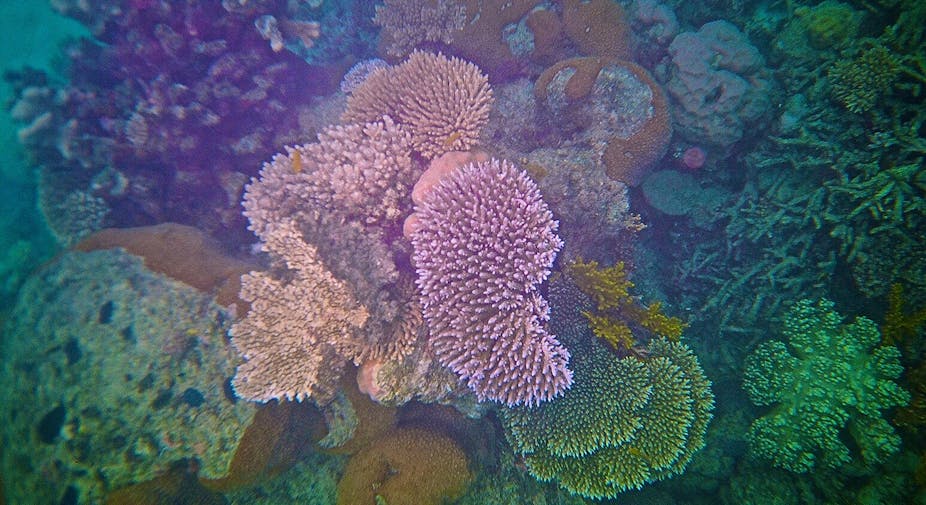The Great Barrier Reef Marine Park Authority has announced it will allow the dumping of three million cubic metres of dredge spoil from the Abbot Point port redevelopment within the marine park’s boundaries, despite other options being available to them.
In doing so, the authority ignored the pleas of a wide coalition of interests that went well beyond the environment movement. The Queensland Tourism Industry Council, the Association of Marine Park Tourism Operators, Whitsunday Charter Boat Industry Association and Dive Queensland had all expressed “grave concerns” about the effects of the dredge-dumping plan on their industry.
So why are so many people concerned? In part, because Australia is now a step closer to seeing the reef being added to a list of World Heritage sites “in danger”, possibly as soon as June this year.
While some may dismiss that “in danger” listing as symbolic, it could affect reef tourism, which Deloitte Access Economics has estimated brings in A$6.4 billion a year to Australia in direct spending and employs more than 64,000 people.
So what happens next? And is there anything Australia can do to avoid being added to that “in danger” list?

Protecting our reputation
The federal government is due to report by tomorrow to the World Heritage Centre about what Australia is doing in response to global concerns about the impacts of climate change and rapid coastal development pressures on the reef.
In June, the World Heritage Committee will then consider whether to add the Great Barrier Reef to its list of iconic global sites officially considered to be “in danger”.
The committee’s principal concerns include the “cumulative” impacts and risks to the reef - that is, the combined effects of several individual developments, including continuing coastal urban development and large-scale port expansions such as the Abbot Point project.
It has asked the Australian government for commitments to “ensure that the legislation protecting the property remains strong and adequate to maintain and enhance its ‘outstanding universal values’”.

Between now and June, if the Australian government can answer the committee’s concerns then there is still a chance that the reef will stay off the “in danger” list - or at least have that decision be deferred. However, the Abbot Point dredge dump decision has undoubtedly made the task much harder.
Meanwhile, the committee has also asked Australia to prepare a long-term sustainability plan, which is due to be completed by February 2015.
As a signatory to the World Heritage Convention, Australia has pledged to implement world’s best practice in protecting the reef for future generations.
International concern
The World Heritage Committee has previously raised concerns about the state of the reef, particularly concerning the dredge-dumping proposals. In its review of the health of the reef it recommended:
A clear and target-driven framework to support planning and assessment of development proposals to protect outstanding universal value, and restore it where necessary, and to ensure resilience of the site, including the consideration of cumulative impacts.
In spite of that international concern, the federal government has made several decisions within the past two months that arguably erode safeguards for the reef, including:
10 December 2013 – granting approval for the Abbot Point port expansion (although it was the Great Barrier Reef Marine Park Authority that took the decision on where to dump the spoil).
13 December 2013 – reaching a revised agreement with the Queensland government (signed by Prime Minister Tony Abbott and Premier Campbell Newman) for a “one-stop shop” on environmental approvals, including decisions about “actions on state land and state waters that impact on the Great Barrier Reef Marine Park”.
20 December 2013 - approving the Galilee Coal and Rail Project, allowing for six new mines and a railway from the mine sites (400km inland) to Abbot Point.
Those are all significant decisions to be making, which will have long-term ramifications for the health and tourism value of the reef.
Seeing the bigger picture
On a more positive note, federal environment minister Greg Hunt has promised that the Australian government will be “examining the cumulative effect of human activities and natural forces rather than looking at impacts in isolation”.

Late last year, the Great Barrier Reef Marine Park Authority also expressed concern over “cumulative impacts of coastal development activities on ecosystem function”. The key question is how will this be achieved given the development decisions that have already been taken.
In November last year, former deputy prime minister and Nationals leader Tim Fischer told a Queensland planning conference that more lateral thinking was needed on ports and coastal development. Mr Fischer suggested that instead of five individual ports along the Queensland coast, each with their own railway line, another option could be one “super port” away from the Great Barrier Reef.
It’s a great idea - but it’s the kind of big-picture thinking that has been sadly lacking in planning for the reef and coastal Queensland to date.

What is really needed to rescue the reef is an integrated regional plan. That would take into account the environmental impacts both on land and on water, from port development and associated infrastructure, coastal urban development, agriculture and tourism. It should also factor in impacts such as farm run-off and climate change.
Without such a plan, decisions such as those taken about Abbot Point are piecemeal and premature.
As a maturing developed nation, it’s time for Australia to decide what is really important to our future. Protecting the Great Barrier Reef – one of the great wonders of the world and a treasure to be preserved for future generations – must be on that list.

